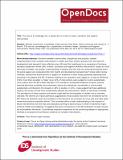| dc.contributor.author | Loevinsohn, Michael | |
| dc.contributor.author | Mehta, Lyla | |
| dc.contributor.author | Cuming, Katie | |
| dc.contributor.author | Nicol, Alan | |
| dc.contributor.author | Cumming, Oliver | |
| dc.contributor.author | Ensink, Jeroen H. J. | |
| dc.date.accessioned | 2014-06-03T10:23:27Z | |
| dc.date.available | 2014-06-03T10:23:27Z | |
| dc.date.issued | 2014-05-29 | |
| dc.identifier.citation | Michael Loevinsohn, Lyla Mehta, Katie Cuming, Alan Nicol, Oliver Cumming, and Jeroen H. J. Ensink. The cost of a knowledge silo: a systematic re-review of water, sanitation and hygiene interventions Health Policy Plan. first published online May 29, 2014 doi:10.1093/heapol/czu039 | en_GB |
| dc.identifier.uri | https://opendocs.ids.ac.uk/opendocs/handle/20.500.12413/3961 | |
| dc.description.abstract | Divisions between communities, disciplinary and practice, impede understanding of how complex interventions in health and other sectors actually work and slow the development and spread of more effective ones. We test this hypothesis by re-reviewing a Cochrane-standard systematic review (SR) of water, sanitation and hygiene (WASH) interventions’ impact on child diarrhoea morbidity: can greater understanding of impacts and how they are achieved be gained when the same papers are reviewed jointly from health and development perspectives? Using realist review methods, researchers examined the 27 papers for evidence of other impact pathways operating than assumed in the papers and SR. Evidence relating to four questions was judged on a scale of likelihood. At the ‘more than possible’ or ‘likely’ level, 22% of interventions were judged to involve substantially more actions than the SR’s label indicated; 37% resulted in substantial additional impacts, beyond reduced diarrhoea morbidity; and unforeseen actions by individuals, households or communities substantially contributed to the impacts in 48% of studies. In 44%, it was judged that these additional impacts and actions would have substantially affected the intervention’s effect on diarrhoea morbidity. The prevalence of these impacts and actions might well be found greater in studies not so narrowly selected. We identify six impact pathways suggested by these studies that were not considered by the SR: these are tentative, given the limitations of the literature we reviewed, but may help stimulate wider review and primary evaluation efforts. This re-review offers a fuller understanding of the impacts of these interventions and how they are produced, pointing to several ways in which investments might enhance health and wellbeing. It suggests that some conclusions of the SR and earlier reviews should be reconsidered. Moreover, it contributes important experience to the continuing debate on appropriate methods to evaluate and synthesize evidence on complex interventions. | en_GB |
| dc.description.sponsorship | The time of J.H.J.E. and O.C. was funded with UK Aid from the Department of International Development (DFID) as part of the SHARE research programme (www.SHAREresearch.org). However, the views expressed do not necessarily reflect DFID's official policies. | en_GB |
| dc.language.iso | en | en_GB |
| dc.publisher | Health Policy and Planning | en_GB |
| dc.rights.uri | http://creativecommons.org/licenses/by/3.0/ | en_GB |
| dc.subject | Health | en_GB |
| dc.subject | Water | en_GB |
| dc.title | The cost of a knowledge silo: a systematic re-review of water, sanitation and hygiene interventions | en_GB |
| dc.type | Article | en_GB |
| dc.rights.holder | The authors | en_GB |
| dc.identifier.externaluri | http://heapol.oxfordjournals.org/content/early/2014/05/29/heapol.czu039.short?rss=1 | en_GB |
| dc.identifier.team | Knowledge Technology and Society | en_GB |


